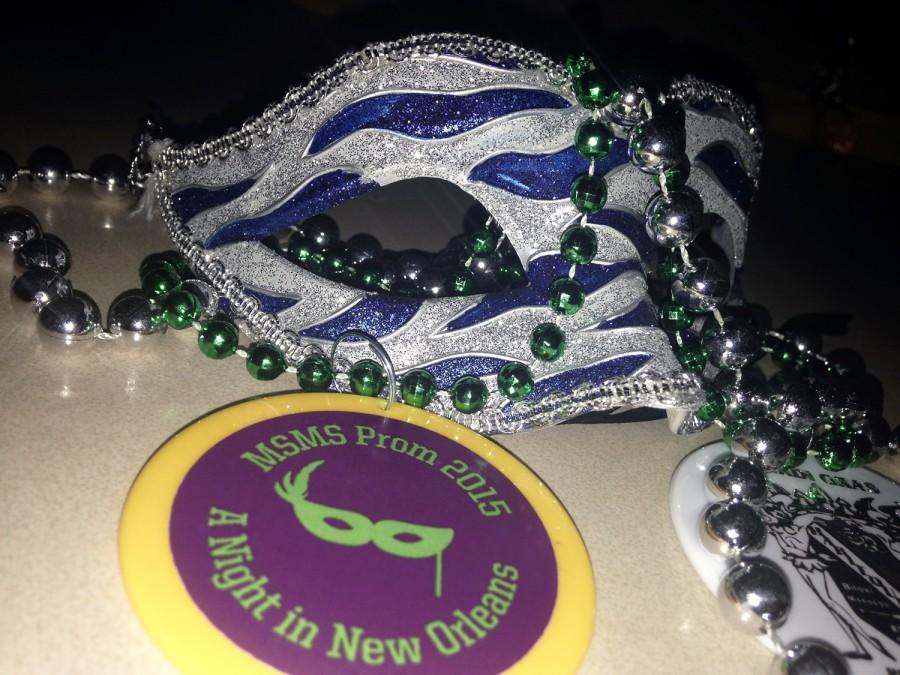Laissez les bons temp rouler: Let the good times roll!
Mardi Gras reaches into lives everywhere, even during the 2015 MSMS prom.
February 3, 2016
Mardi Gras is a holiday that many MSMS students discuss this time of year to express their love for the more coastal tradition. It is widely believed that Mardi Gras came to America through New Orleans, La.; however, the first true celebration was held in 1703 in Mobile, Ala. At the time, this area was called Fort Louis de la Mobile, which was established by French-Canadian explorer Jean Baptiste Le Moyne Sieur de Bienville in 1702. It was in Mobile where the first forms of Mardi Gras “krewes” came to light.
Established by Bienville in 1718, New Orleans had embraced Mardi Gras by the 1730s, and it was Louisiana’s governor Marquis de Vaudreuil who set the precedent for extravagant Mardi Gras balls. The second New Orleans krewe in 1870, known as the Twelfth Night Revelers, began the recorded tradition of throwing Mardi Gras novelties from floats during parades.
Mardi Gras — Fat Tuesday in French — is famous for influencing chaotic behavior amongst participants, yet the origins of the holiday lie in Catholicism. Mardi Gras itself only refers to the Tuesday preceding Ash Wednesday, but Mardi Gras season, which is known as Carnival, technically begins on the Christian holiday Epiphany — also known as the Twelfth Day of Christmas or the Three Kings Day — and ends on midnight of Fat Tuesday. As soon as the clock strikes midnight, it is Ash Wednesday, and 40 days of Lent follow. The holiday is meant as a last chance for people to take their vices before they take their vows for Lent.
Modern celebrations for Mardi Gras can begin as early as November, but most balls and parades do not occur until early January, leading up to Fat Tuesday. Parades and most balls are sponsored by individual krewes, which are societies of people who pay fees year-round to finance balls and create floats. These krewes are responsible for organizing their events according to city ordinances, as they must get permits to block off roads for the parades.
During balls, it is typical for a queen and/or king to be crowned for that specific krewe; the Mardi Gras royalty are then dressed up and displayed on floats during parades. Dress codes for balls range from cocktail attire to formal evening gowns, depending on the krewe.
Mardi Gras parades consist of long processions of vehicles with people who throw objects into gathered crowds. The vehicles can be decorated trailers or luxurious, rolling pavilions that are specifically designed to be floats in parades. It is common for floats to have their own music as their passengers toss candies, toys and trinkets into the crowds. Common items are beads, moonpies, medallions, doubloons and stuffed animals.
Resident of Gulfport, Hakeem Mikle said, “First Mardi Gras parade I went to was when I was 7 years old. I remember catching one of those toy axes. I also remember catching a large amount of moon pies. After taking my first bite, I determined that moon pies are terrible.”
This year, Mardi Gras falls on Feb. 9, and the krewes are in full swing in most regions of Louisiana, Mississippi and Alabama. In Mississippi, Mardi Gras is most prominent on the Gulf Coast. Gulfport resident Kendall Palmer said, “I’ve been celebrating Mardi Gras since I was born in Baton Rouge. I was raised on Mardi Gras. My favorite part about it is the parades. It’s one big party; everyone is happy, having a good time. There are no worries.”









